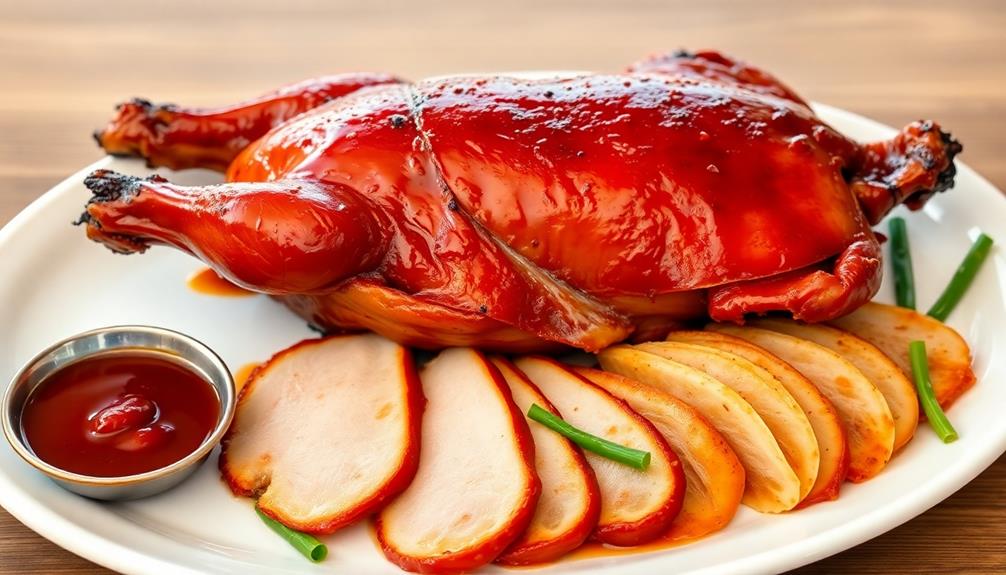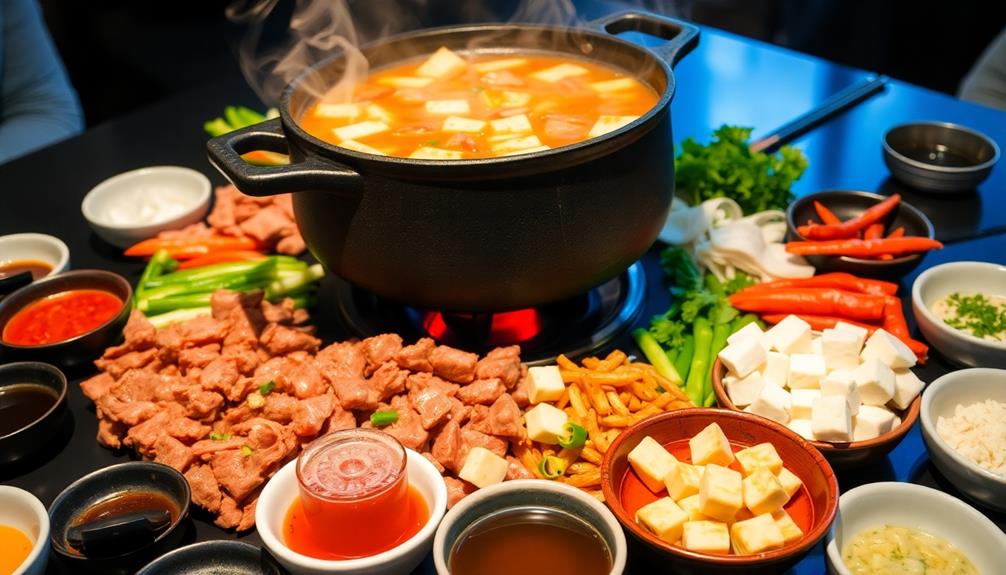You're in for a real treat with General Tso's Chicken! This Chinese-American dish features crispy, bite-sized pieces of chicken in a sweet and savory sauce. The chicken gets its crunch from being coated in cornstarch and fried to perfection. The sauce is a delicious blend of soy sauce, vinegar, and brown sugar – it's got a wonderful balance of flavors! Serve it up over a bed of steaming white rice, and you've got yourself an easy, crave-worthy dinner. Want to learn the key steps to making this dish at home? Keep reading to discover the secrets behind this classic!
Key Takeaways
- General Tso's Chicken is a popular Chinese-American dish featuring crispy fried chicken in a sweet and tangy sauce.
- The dish originated in the 1970s by Taiwanese chef Peng Chang-kuei, created to appeal to American tastes.
- The recipe typically includes boneless, skinless chicken, soy sauce, rice vinegar, hoisin sauce, and cornstarch.
- Marinating the chicken, frying it in batches, and preparing the sauce are key techniques for achieving the desired texture and flavor.
- General Tso's Chicken is often served with steamed rice and can be garnished with green onions for freshness.
History
General Tso's Chicken has a fascinating history. You might be surprised to learn that this beloved dish didn't actually originate in China! Instead, it was created in the 1970s by a Taiwanese chef named Peng Chang-kuei.
Peng was cooking in a restaurant in New York City when he developed the recipe for this tasty chicken dish. The story goes that Peng wanted to create a unique dish that would appeal to American tastes. He experimented with different flavors and techniques, eventually landing on a combination of crispy fried chicken, a sweet and savory sauce, and a touch of spice.
The result was an instant hit, and General Tso's Chicken quickly became a staple on Chinese restaurant menus across the United States. Over the years, the dish has evolved and taken on regional variations, but the core elements – the crispy chicken, the bold flavors, and the chef's creative flair – remain the same.
Today, General Tso's Chicken is enjoyed by people all around the world, a testament to the power of culinary innovation and the enduring appeal of delicious food.
Recipe
General Tso's Chicken is a popular Chinese-American dish that features crispy chicken in a sweet and tangy sauce. This recipe will guide you through the steps to create an authentic and flavorful version of this iconic dish.
First, it's important to understand the origins of General Tso's Chicken. Though often attributed to Chinese cuisine, this dish is actually a creation of American-Chinese restaurants in the 1970s. The dish was named after a 19th-century Qing dynasty military leader, General Tso Tsung-t'ang, but the connection to his legacy is largely symbolic.
- 1 lb boneless, skinless chicken thighs, cut into 1-inch pieces
- 2 tablespoons soy sauce
- 1 tablespoon rice vinegar
- 2 teaspoons cornstarch
- 1 teaspoon sesame oil
- 1/4 cup vegetable oil
- 3 cloves garlic, minced
- 1 tablespoon grated ginger
- 1/4 cup chicken broth
- 2 tablespoons hoisin sauce
- 1 tablespoon rice vinegar
- 1 tablespoon brown sugar
- 1 teaspoon chili garlic sauce (or to taste)
- 2 green onions, sliced
To cook the dish, start by marinating the chicken in a mixture of soy sauce, rice vinegar, cornstarch, and sesame oil. Allow it to sit for at least 30 minutes.
In a wok or large skillet, heat the vegetable oil over high heat. Working in batches if necessary, fry the chicken until golden brown and crispy. Remove the chicken from the oil and set aside.
In the same wok, sauté the garlic and ginger until fragrant. Add the chicken broth, hoisin sauce, rice vinegar, brown sugar, and chili garlic sauce. Bring the sauce to a simmer and let it thicken slightly.
Return the fried chicken to the wok and toss to coat the pieces evenly in the sauce. Garnish with sliced green onions and serve immediately over steamed rice.
When cooking this dish, be sure to fry the chicken in small batches to ensure even cooking and crisping. Additionally, adjust the amount of chili garlic sauce to your desired level of spiciness. Enjoy your authentic General Tso's Chicken!
Cooking Steps
Cut the chicken into bite-sized pieces, then coat them in cornstarch to get them nice and crispy when you fry them up.
Once the chicken is golden brown, you'll make a tasty sauce to toss it in.
Get ready to enjoy the perfect balance of sweet and savory in every delicious bite!
Step 1. Cut Chicken Into Bite-Sized Pieces
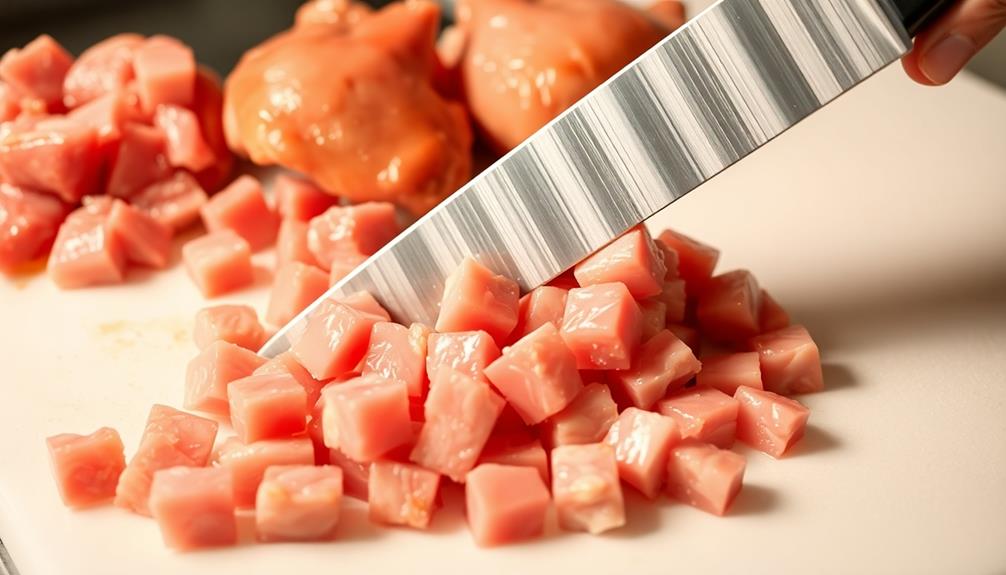
Take the chicken breasts and cut them into bite-sized pieces.
You'll want each piece to be around an inch or two in size – not too big, but not too small either. Use a sharp knife to make clean, even cuts, and try to get all the pieces about the same size so they cook evenly.
If you have any larger chunks, you can cut them in half to make them more manageable. Take your time and be careful with the knife – you don't want any accidents!
Once you've got all the chicken cut up, give the pieces a quick rinse under cold water to clean them off.
Pat them dry with some paper towels, and you're ready to move on to the next step.
Cutting the chicken into the right size is an important part of making delicious General Tso's, so take your time and do it right!
Step 2. Coat Chicken With Cornstarch

Next, you'll want to coat the chicken pieces in cornstarch. This important step helps create a delightfully crispy exterior once the chicken is fried.
Grab a shallow bowl and pour in some cornstarch. Toss the bite-sized chicken pieces into the bowl, making sure each piece is thoroughly coated on all sides. Use your hands to gently toss and turn the chicken, ensuring an even layer of cornstarch.
The cornstarch will cling to the chicken, forming a thin, protective crust that'll get wonderfully crispy when it hits the hot oil. Once the chicken is fully coated, you're ready to move on to the next step – frying it up!
Get your oil nice and hot, then carefully add the coated chicken pieces. They'll sizzle and turn golden brown, transforming into the delicious, crispy chicken you know and love.
Just be careful not to overcrowd the pan – fry the chicken in batches for best results.
Step 3. Fry Chicken Pieces Until Golden
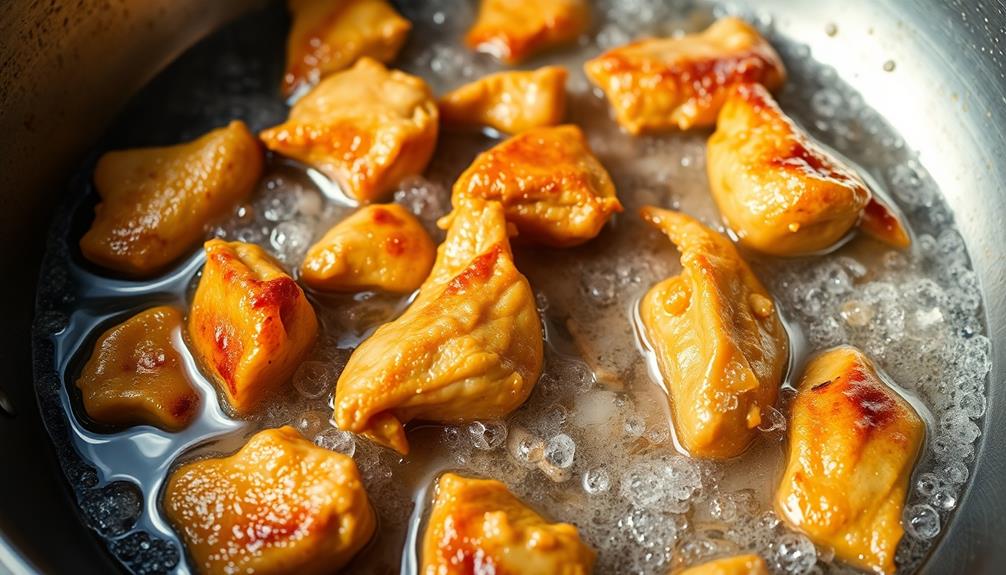
With the chicken pieces now coated in a light dusting of cornstarch, it's time to fry them to golden perfection.
In a large skillet or wok, heat about 1 inch of oil over medium-high heat until it shimmers. Carefully add the chicken pieces one by one, making sure not to overcrowd the pan.
Fry the chicken for 2-3 minutes per side, turning occasionally, until they're a beautiful golden-brown color. You'll know they're ready when you can see a crispy, crunchy crust forming on the outside.
Drain the fried chicken on a paper towel-lined plate to soak up any excess oil. Be careful, as the oil will be hot!
Once all the chicken is fried, you're one step closer to enjoying the classic flavors of General Tso's Chicken. Get ready to toss the fried chicken in the tasty sauce – it's about to get delicious!
Step 4. Make Sauce
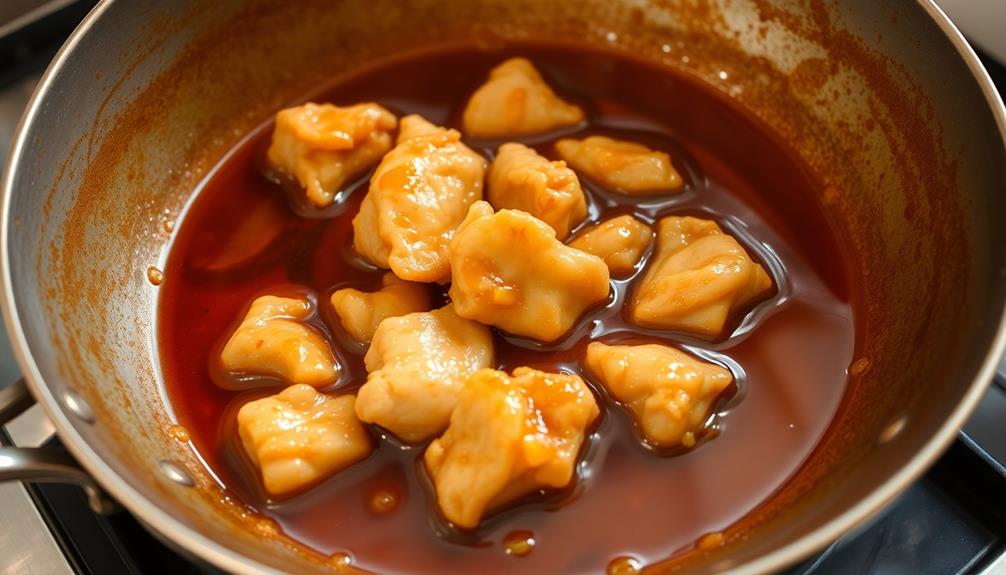
While the chicken is frying, let's get started on the tasty sauce! In a medium-sized saucepan, combine the soy sauce, rice vinegar, brown sugar, and ginger. Whisk these ingredients together until the sugar has dissolved.
Now, add the chicken broth and bring the mixture to a simmer over medium heat. Let it bubble away for about 5 minutes, stirring occasionally, until the sauce has thickened up nicely.
Next, in a small bowl, whisk together the cornstarch and water to make a smooth slurry. Slowly pour this into the simmering sauce, whisking constantly, to thicken it up even more.
You'll see the sauce transform into a lovely, glossy coating. Finally, stir in the toasted sesame oil, which will add a delightful nutty flavor.
The sauce is now ready to be poured over your crispy fried chicken. Get ready for an explosion of sweet, savory, and tangy goodness in every bite!
Step 5. Combine Chicken and Sauce
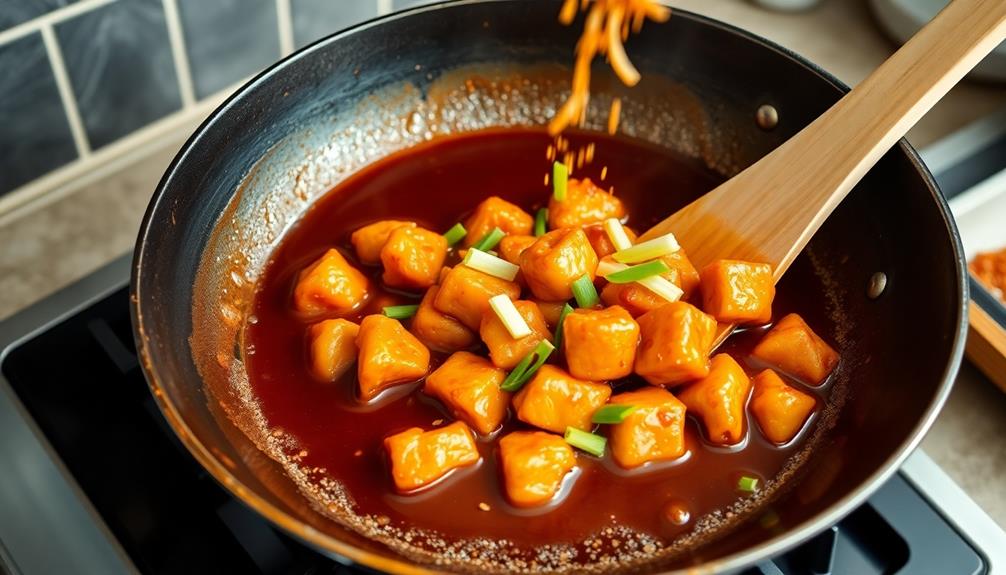
Once the sauce has thickened up, it's time to combine it with the crispy fried chicken. Grab the pan with the delicious sauce and carefully pour it over the chicken pieces.
Gently toss the chicken, making sure each piece is evenly coated in the savory, slightly sweet sauce. The sauce should cling beautifully to the crunchy exterior of the chicken, creating an irresistible texture. You can now place the chicken on a baking sheet and pop it into the oven to finish cooking. As the chicken bakes, the aroma of the savory sauce will fill your kitchen, teasing your taste buds and making your mouth water in anticipation. This dish, known for its delectable flavors and textures, has a rich history that dates back to ancient China, often referred to as the history of beggar’s chicken. Legend has it that a beggar stole a chicken and, lacking the proper tools to cook it, resorted to wrapping it in lotus leaves and clay before burying it in the ground and building a fire on top. This resulted in a moist, tender chicken with a unique earthy flavor, and the dish has been enjoyed ever since.
Now, let the chicken and sauce mingle for a minute or two, allowing the flavors to really soak in. The chicken will glisten with the glossy sauce, looking absolutely mouthwatering.
Give it a final gentle toss to ensure everything is well combined. Alright, your General Tso's Chicken is now ready to serve!
Scoop it up and get ready to enjoy the most delicious, saucy, and crispy chicken you've ever tasted. The perfect balance of savory, sweet, and heat is about to delight your taste buds.
Final Thoughts
General Tso's chicken is a beloved dish that has captured the hearts and taste buds of many. As you've seen, creating this delightful meal is quite simple.
The key is to combine the perfectly crispy chicken with the tantalizing sweet and savory sauce. When you take that first bite, you'll be met with a burst of flavors that dance on your tongue. The tender chicken, the garlicky punch, the subtle heat – it all comes together in perfect harmony.
Now that you know the steps, why not try making General Tso's chicken at home? Impress your family and friends with your culinary skills.
They'll be amazed at how restaurant-quality this dish can be. So, go ahead, channel your inner chef and whip up a batch of this Chinese takeout classic. Your taste buds are sure to thank you!
Frequently Asked Questions
Is General Tso's Chicken Named After a Real Person?
Yes, General Tso's chicken is named after a real person. The dish was created in the 1950s and was named after a Qing dynasty military leader, Zuo Zongtang, also known as General Tso.
What Is the Origin of the Dish's Distinctive Orange-Red Color?
The distinctive orange-red color of the dish comes from the combination of soy sauce, rice vinegar, and chile peppers or chili paste you use to create the savory, slightly sweet, and spicy sauce that coats the fried chicken.
Is General Tso's Chicken Considered Authentic Chinese Cuisine?
No, General Tso's Chicken isn't considered authentic Chinese cuisine. It's an American creation that doesn't resemble any traditional Chinese dish. The distinctive orange-red color comes from the use of food coloring, not authentic Chinese ingredients.
How Did General Tso's Chicken Become Popular in the United States?
You may be surprised to learn that General Tso's Chicken's popularity in the United States is largely due to its adaptation by Chinese-American restaurateurs to cater to American tastes and preferences, becoming a beloved dish in the process.
Can General Tso's Chicken Be Made at Home With Ease?
You can definitely make General Tso's chicken at home with ease. The dish only requires a few simple ingredients, and the cooking process is straightforward, making it an excellent choice for a homemade meal.



